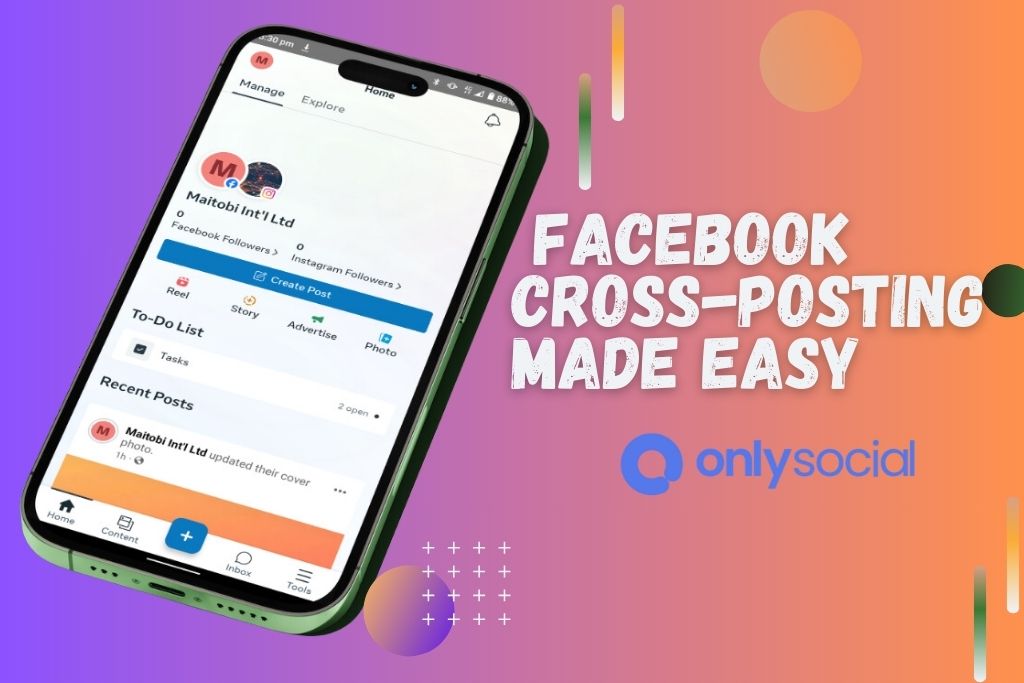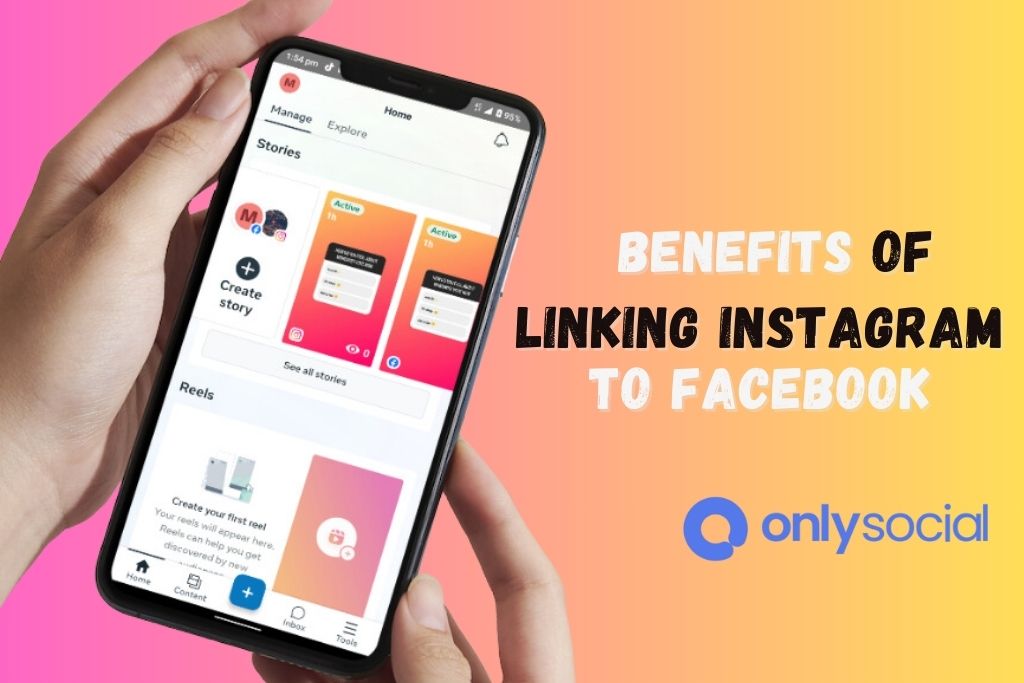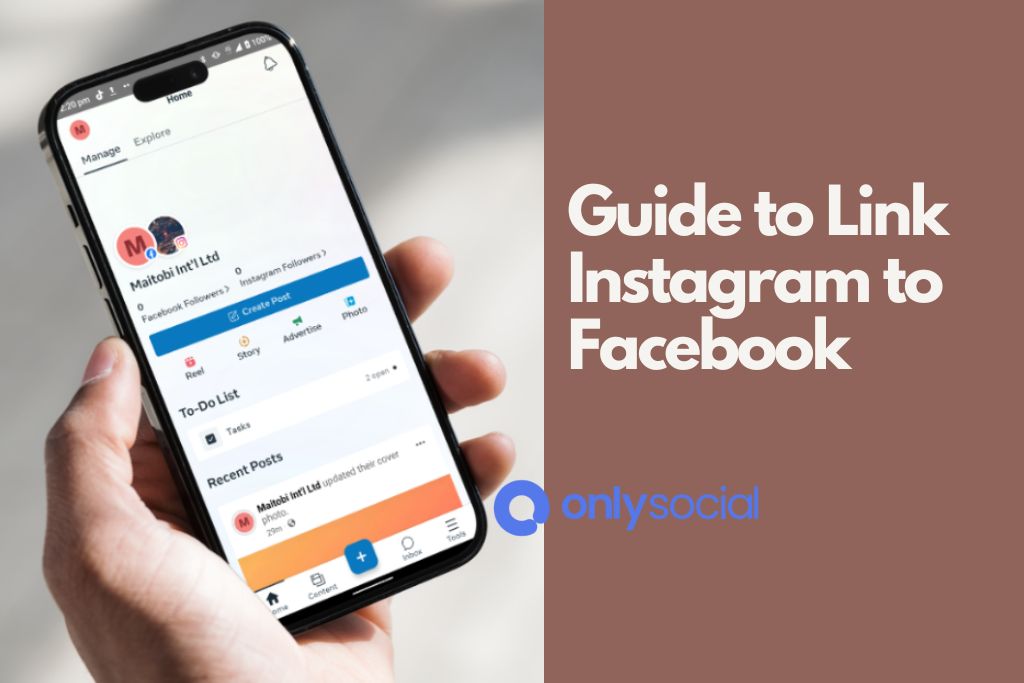How To Link Instagram To Facebook Cross-Posting Made Easy

Are you looking to streamline your social media presence? Linking Instagram to Facebook has become a popular way to seamlessly cross-post your content. This comprehensive guide will walk you through the process effortlessly, highlighting the numerous advantages of this integration. Following our step-by-step instructions and addressing privacy concerns will give you valuable insights into optimizing your cross-posted content. We’ll also explore advanced options and provide methods to disconnect if needed.
Moreover, this article will explore how leveraging cross-posting as a strategic tool can contribute to your business growth. We’ll share best practices to ensure seamless integration across both platforms.
So, let’s get started and take your social media game to the next level!
Key Points:
- Linking Instagram to Facebook is a popular method for cross-posting content.
- This article provides a comprehensive guide to effortlessly connecting these platforms.
- Explore step-by-step instructions and address privacy concerns.
- Learn how to optimize your cross-posted content and explore advanced options.
- Discover how cross-posting can be a strategic tool for business growth.
- Best practices for seamless integration across both platforms will be discussed.
Let’s dive in and master linking Instagram to Facebook for effective cross-posting!
Table of Contents
- 1 Benefits of Linking Instagram to Facebook
- 2 Step-by-Step Guide to Link Instagram to Facebook
- 3 Understanding the Cross-Posting Feature
- 4 Ensuring Privacy Settings When Linking Instagram to Facebook
- 5 Tips for Optimizing Cross-Posted Content on Facebook
- 6 Troubleshooting Common Issues With Instagram-Facebook Linking
- 7 Exploring Advanced Cross-Posting Options
- 8 How to Disconnect Instagram From Facebook
- 9 Leveraging Cross-Posting for Business Growth
- 10 Best Practices for Cross-Posting on Instagram and Facebook
- 11 Frequently Asked Questions
- 11.1 Can I Link Multiple Instagram Accounts to One Facebook Account?
- 11.2 What Happens if I Unlink My Instagram Account From Facebook?
- 11.3 Can I Choose Which Facebook Page I Want to Cross-Post To?
- 11.4 Will Cross-Posting My Instagram Content Affect My Facebook Reach?
- 11.5 Can I Still Edit My Instagram Posts After They Have Been Cross-Posted to Facebook?
Benefits of Linking Instagram to Facebook
Linking Instagram to Facebook offers several benefits, including increased reach and visibility for content, seamless cross-posting capabilities, and the ability to leverage both platforms’ user bases.
By connecting these two social media platforms, users can expand their audience and enhance their social media strategy.
One of the key advantages of linking Instagram to Facebook is the increased reach and visibility of content. With over 2 billion active monthly users on Facebook and more than 1 billion active monthly users on Instagram, businesses and individuals can tap into a larger pool of potential followers or customers. This connection allows for greater exposure to diverse audiences across both platforms.
Additionally, the seamless cross-posting capabilities provided by linking Instagram to Facebook streamline content sharing. Users can easily share posts from one platform to the other with just a few clicks, eliminating the need for manual reposts or duplicate uploads. This saves time and effort while ensuring a consistent presence across multiple channels.
Moreover, leveraging both platforms’ user bases provides an opportunity to connect with a wider range of individuals who may have different preferences in consuming content. By integrating Instagram’s visual-centric approach with Facebook’s comprehensive networking capabilities, users can engage with various demographics effectively.
While there are many benefits to linking Instagram to Facebook, it is essential to consider data security as well. Users should understand how their data will be shared between the two platforms before making this connection. Implementing appropriate privacy settings and exercising caution when granting permissions can help mitigate any potential risks associated with data security concerns.
Step-by-Step Guide to Link Instagram to Facebook
This discussion will explore the benefits of cross-posting and address common issues that arise during the process.
Cross-posting, or linking Instagram to Facebook, offers advantages such as increased visibility and reach, streamlined content sharing, and easier management of multiple platforms.
However, there are also common problems that users may encounter when attempting to link the two platforms, including technical difficulties and privacy concerns.
Benefits of Cross-Posting
One advantage of cross-posting on Instagram and Facebook is that it allows users to reach a larger audience by leveraging the combined user bases of both platforms. This can particularly benefit businesses and individuals looking to increase their online visibility.
Some benefits of cross-posting include:
- Increased Reach: By sharing content on both platforms simultaneously, users can maximize their reach and potentially attract new followers or customers.
- Time-Saving Automation: Cross-posting eliminates the need to manually upload content on multiple platforms, saving time and effort.
- Consistent Branding: Cross-posting helps maintain a consistent brand image across different social media channels, ensuring the message is unified.
- Enhanced Engagement: Cross-posting can increase engagement levels by tapping into two different user communities as more people access the content.
Overall, cross-posting provides several advantages in automation, increasing online visibility, and reaching a wider audience.
Troubleshooting Common Issues
To troubleshoot common issues encountered during the process, users can refer to available online resources or seek assistance from customer support.
Linking Instagram to Facebook for cross-posting purposes is generally straightforward; however, users may encounter some common problems.
One of the most frequently reported issues is difficulty logging in to both accounts simultaneously. This can be resolved by ensuring that the correct login credentials are entered and that Instagram and Facebook apps are updated to their latest versions.
Another common problem is the failure of images or videos to be posted on Facebook after being shared on Instagram. This can often be resolved by checking the privacy settings on both platforms and adjusting them accordingly.
If these troubleshooting steps do not resolve the issue, users should contact customer support for further assistance.
Understanding the Cross-Posting Feature
The cross-posting feature allows users to seamlessly share their Instagram posts on Facebook, providing a convenient way to reach a wider audience across both platforms. Understanding the benefits of this feature can help users make the most out of their social media presence.
Here are some key points to consider:
- Increased visibility: By cross-posting, users can expand their reach and increase their chances of engagement from followers on both Instagram and Facebook.
- Time-saving: Instead of manually uploading content on each platform separately, cross-posting allows for automatic sharing, saving time and effort.
- Consistent branding: Cross-posting ensures the same content is displayed on both platforms, maintaining a cohesive brand image.
- Analytics integration: When linking Instagram to Facebook, users gain access to combined analytics data from both platforms, enabling them to track performance more effectively.
To troubleshoot any potential issues with cross-posting between Instagram and Facebook, here are some tips:
- Check account settings: Ensure that the accounts are linked correctly in the settings section of both platforms.
- Permissions: Verify that the necessary permissions have been granted for sharing content between the two platforms.
- Privacy settings: You should double-check your privacy settings on both Instagram and Facebook to ensure that your posts are visible to the intended audience.
- Update apps: Ensure that Instagram and Facebook apps are updated to their latest versions for optimal functionality.
Ensuring Privacy Settings When Linking Instagram to Facebook
This discussion focuses on the privacy concerns addressed when linking Instagram to Facebook.
The implications of data sharing between these platforms are also examined.
Additionally, strategies for protecting personal information are discussed.
It is essential to understand how these social media platforms handle user data and what measures are in place to safeguard privacy.
Privacy Concerns Addressed
Privacy concerns surrounding the linkage of Instagram and Facebook can be effectively addressed through the careful implementation of privacy settings and user education. Users can maintain control over their personal information by taking these steps and ensuring that their data is shared only with intended recipients.
- Customize Privacy Settings: Both Instagram and Facebook offer a range of privacy settings that allow users to control who can view their posts, profile information, and contact details. Users should take advantage of these options to limit access to their data.
- Understand Data Sharing: When linking Instagram to Facebook, users must understand what data will be shared between the two platforms. This includes photos, videos, captions, comments, likes, and followers’ names. Being aware of this enables users to make informed decisions about cross-posting content.
- Regularly Review Settings: Privacy settings may change over time due to platform updates or policy revisions. It is crucial for users to regularly review their privacy settings on both Instagram and Facebook to ensure they are still aligned with their preferences.
- Educate Yourself: Staying informed about the latest privacy features and policies on both platforms is essential to protecting your data. Users should actively seek out educational resources from Instagram and Facebook to stay up-to-date on best practices for maintaining privacy while linking the two accounts.
Data Sharing Implications
Data sharing between social media platforms can significantly affect user privacy and control over personal information. While linking Instagram to Facebook through cross-posting offers convenience and ease of use, it raises concerns regarding data security and user consent. Users who link their accounts allow the two platforms to share their data, including profile information, photos, and activity. This data sharing can expose users to various privacy risks, such as unauthorized access or misuse of their information. Additionally, the issue of user consent becomes crucial in this context. Social media platforms must ensure that users understand the extent of data sharing involved and provide clear options for controlling what information is shared with linked accounts.
| Data Sharing Implications | ||
|---|---|---|
| Concerns | Data Security | User Consent |
| Risks | Unauthorized Access | Lack of Transparency |
| Control | Privacy Settings | Opt-out Options |
Table: Implications of Data Sharing Between Social Media Platforms
Protecting Personal Information
Protecting personal information requires implementing robust security measures and ensuring user awareness of the potential risks of sharing data between social media platforms. Addressing privacy concerns and safeguarding sensitive information is crucial when linking Instagram to Facebook.
Here are four key steps to protect personal information while cross-posting:
- Enable two-factor authentication: This adds an extra layer of security by requiring users to provide a verification code and their password.
- Review app permissions: Regularly review the access granted to third-party apps linked to your social media accounts and revoke unnecessary privileges.
- Adjust privacy settings: Customize privacy settings on both Instagram and Facebook, limiting the visibility of personal information only to trusted individuals or friends.
- Be cautious with public posts: Avoid sharing highly personal details or sensitive content openly, which may compromise your privacy.
Tips for Optimizing Cross-Posted Content on Facebook
One effective strategy for enhancing the performance of cross-posted content on Facebook is to carefully tailor the format and messaging of the posts to align with the platform’s unique features and user preferences. Content creators can maximize their reach and impact on Facebook by optimizing engagement and increasing visibility.
To optimize engagement, it is essential to understand how users interact with content on Facebook. For instance, attention-grabbing headlines or captions can entice users to click on the post and read further. Additionally, incorporating visually appealing images or videos can capture users’ attention and encourage them to engage with the content by liking, commenting, or sharing.
Increasing visibility requires understanding the algorithms determining which posts appear in users’ newsfeeds. It is crucial to consider factors such as timing and frequency of posting to improve visibility. Posting at peak times when user activity is high can increase the likelihood of reaching a larger audience. Furthermore, regular posting ensures that your content remains visible in users’ feeds over time.
Troubleshooting Common Issues With Instagram-Facebook Linking
This discussion will focus on troubleshooting common issues with Instagram-Facebook linking, specifically addressing syncing problems and solutions, as well as error messages and fixes.
Syncing problems can arise when attempting to link the two platforms, resulting in content not being adequately shared or updated across both accounts.
Error messages may occur during the linking process, providing valuable information that can guide users towards resolving the issue.
Syncing Problems and Solutions
Syncing problems may arise when attempting to link Instagram to Facebook, but various solutions are available to address these issues.
Here are some troubleshooting tips to help resolve syncing problems:
- Update the apps: Ensure your Instagram and Facebook apps are updated to their latest versions. Outdated versions can cause compatibility issues.
- Check permissions: Ensure you have granted the necessary permissions for Instagram and Facebook to access each other’s accounts. Go to Settings > Apps > Instagram/Facebook and check if all permissions are enabled.
- Reconnect accounts: Disconnect and then reconnect your Instagram and Facebook accounts. This can refresh the connection between the two platforms.
- Clear cache: Clearing the cache of both apps can eliminate any temporary data or glitches affecting the syncing process.
Error Messages and Fixes
If you encounter error messages while attempting to connect Instagram and Facebook, it is important to follow specific troubleshooting steps to resolve these issues.
One common error message users may encounter is ‘Instagram Cannot Connect to Facebook.’ This error typically occurs when there is a problem with the connection between the two platforms. To fix this issue, users can try logging out of both Instagram and Facebook, clearing their browser cache and cookies, and then logging back in.
Another error message may be encountered: ‘ Failed to Post on Facebook.’ This error message indicates an issue posting content from Instagram to Facebook. Troubleshooting solutions for this problem include checking if the user has permission for Instagram to post on their behalf in their Facebook settings, ensuring they have a stable internet connection, and updating both apps to the latest versions.
Exploring Advanced Cross-Posting Options
To further enhance cross-posting between Instagram and Facebook, users can explore advanced options that allow for more customization and control over the content shared on both platforms. These advanced cross-posting strategies aim to maximize engagement through cross-posting by providing users with additional tools and features.
- Customized captions: With advanced cross-posting options, users can customize the captions accompanying their posts on both Instagram and Facebook. This allows for tailoring the messaging to suit the respective audiences of each platform.
- Selective sharing: Users can selectively choose which posts they want to share between Instagram and Facebook. This ensures that only relevant content is shared across platforms, maintaining consistency while catering to specific audience preferences.
- Cross-platform tagging: Advanced cross-posting options enable users to tag other accounts on both platforms simultaneously. This facilitates increased visibility and engagement, as tagged accounts are notified on both platforms, potentially leading to broader reach.
- Scheduling flexibility: Advanced options give users greater control over when their posts are shared across platforms. This enables strategic scheduling based on peak engagement times on each platform, maximizing reach and interaction.
How to Disconnect Instagram From Facebook
By disconnecting Instagram from Facebook, users can effectively separate their accounts and discontinue sharing content between the two platforms.
Disconnecting Instagram from Facebook is a relatively simple process that can be done through the settings menu on both platforms.
On Instagram, users can unlink their Facebook account by accessing the ‘Settings’ tab, selecting ‘Privacy and Security,’ and then choosing ‘Linked Accounts.’ From there, they can select ‘Facebook’ and click ‘Unlink Account.’
Conversely, users can disconnect their Instagram account on Facebook by going to the ‘Settings & Privacy’ menu, clicking on ‘Settings,’ selecting ‘Apps and Websites,’ and then choosing ‘Instagram.’ Finally, they must click the option to remove the connection between Facebook and Instagram.
It is important to note that once this disconnection is made, users can no longer share posts or stories between the two platforms automatically. However, it offers individuals greater control over their privacy and enables them to manage their online presence more effectively.
Leveraging Cross-Posting for Business Growth
Utilizing the feature of sharing content between different social media platforms can be a strategic approach for businesses looking to expand their reach and engage with a broader audience. Cross-posting, or cross-promotion or syndication, allows businesses to share their content simultaneously across multiple social media platforms. This method of leveraging cross-posting has become increasingly popular in recent years due to its potential benefits for business growth.
Here are four reasons why businesses should consider incorporating cross-posting into their social media marketing strategies:
- Increased visibility: By sharing content on multiple platforms, businesses can increase their visibility and reach a wider audience. This can lead to greater brand exposure and potentially attract new customers.
- Time-saving: Cross-posting eliminates the need to manually post content on each platform individually, saving time and effort for businesses. Instead, they can create and share one piece of content across all connected platforms.
- Consistency in messaging: Cross-posting ensures that businesses maintain consistency across different platforms. This helps reinforce brand identity and strengthens customer trust.
- Enhanced engagement: Sharing content across multiple platforms increases the likelihood of engagement from diverse audiences. This can result in more likes, comments, and shares, ultimately driving higher conversion rates.
Best Practices for Cross-Posting on Instagram and Facebook
To maximize the benefits of cross-posting on Instagram and Facebook, following best practices and optimizing the content for both platforms is important. The table below highlights some key recommendations for successfully cross-posting on these social media platforms:
| Best Practices | Optimizing Content |
|---|---|
| Use consistent branding | Tailor content for each platform |
| Engage with your audience | Utilize appropriate hashtags |
| Post at optimal times | Include high-quality visuals |
Consistency in branding is crucial when cross-posting between Instagram and Facebook. This includes using the same logo, color scheme, and tone of voice across both platforms. Engaging with your audience is equally important – respond to comments, ask questions, and foster meaningful conversations.
Tailoring content to each platform’s unique features is essential when optimizing it. While Instagram favors visually appealing content such as photos and videos, Facebook allows for more extended captions and a more comprehensive range of post types. Additionally, using relevant hashtags can help increase visibility on Instagram.
Timing also plays a significant role in maximizing engagement. Research shows that posting during peak hours can lead to better reach and interaction with your audience.
Frequently Asked Questions
Can I Link Multiple Instagram Accounts to One Facebook Account?
The integration of multiple Instagram accounts with one Facebook account is a feature that allows users to link and cross-post content across platforms. This function facilitates efficient management and visibility for individuals or businesses operating multiple Instagram accounts.
What Happens if I Unlink My Instagram Account From Facebook?
Unlinking an Instagram account from Facebook can have potential consequences. It may result in the loss of cross-posting functionality, making it necessary to share content on both platforms manually. Alternative methods for sharing Instagram content on Facebook should be explored.
Can I Choose Which Facebook Page I Want to Cross-Post To?
The Instagram platform allows users to select specific Facebook pages for cross-posting and to manage cross-posting settings. Users can choose which Facebook page their content will be shared on.
Will Cross-Posting My Instagram Content Affect My Facebook Reach?
Cross-posting from Instagram to Facebook can impact engagement metrics on Facebook. Businesses can use cross-posting on both platforms to maximize their reach and increase visibility.
Can I Still Edit My Instagram Posts After They Have Been Cross-Posted to Facebook?
The ability to edit Instagram posts after they have been cross-posted to Facebook is subject to editing limitations. However, the post visibility on both platforms remains unaffected by any subsequent edits made on Instagram.


